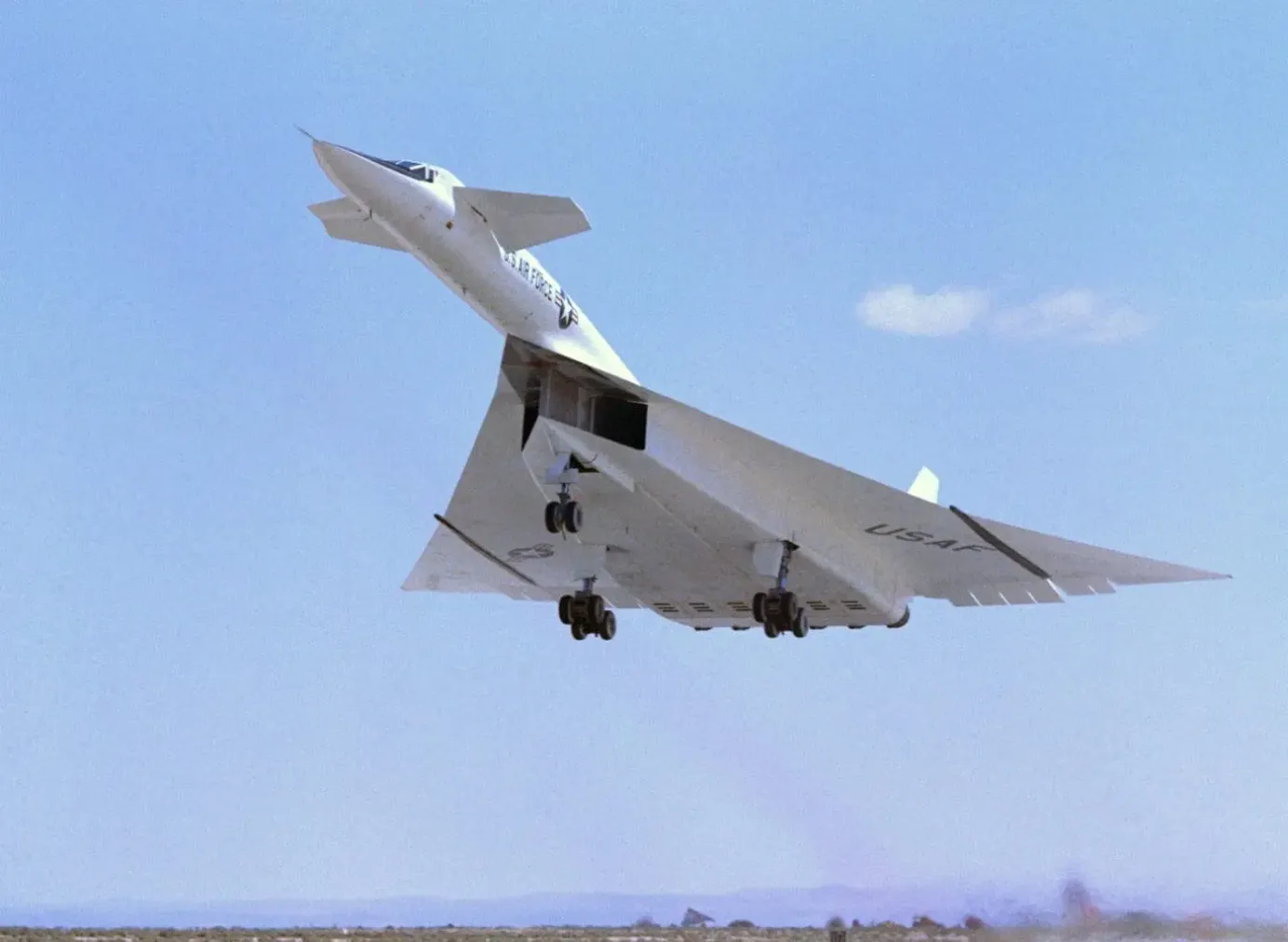
Meet the XB-70 Valkyrie - the Legendary Bomber That You Never Heard Of
The futuristic bomber aircraft capable of delivering nuclear weapons into Soviet territory at three times the speed of sound.
Table of Contents
A bomber aircraft capable of flying at Mach 3 at 70.000 feet for thousands of miles while carrying nuclear weapons deep into hostile terretory.
In the 1950s United States of America engaged in a cold war with the Soviet Union, such a plane was more a science fiction idea than anything real.
It was nonetheless what the United States Air Force looked for in the 1950s. They decided to go ahead with a full-scale development project for such a plane. Despite soaring costs and technological developments that deemed the new aircraft redundant from early on, two prototypes were built.
The following years offered plenty of bumps on the road. Even a tragic crash. But as a research plane, it helped advance the supersonic flight technology that later became essential to other iconic aircraft.
Here is the story of the legendary bomber that you probably never heard of. The North American XB-70 Valkyrie.
What Makes the XB-70 Valkyrie So Special?
The XB-70 Valkyrie was the prototype version of the proposed B-70 supersonic bomber aircraft for the United States Air Force. It would serve as a deep penetration strategic bomber armed with nuclear weapons.
More interestingly it would be capable of flying faster than Mach 3 - more than three times as fast as regular bomber aircraft. Six General Electric YJ93-GE-3 afterburner-equipped turbojet engines would propel the bomber to these high speeds. But why did the United States Air Force want such a fast aircraft?
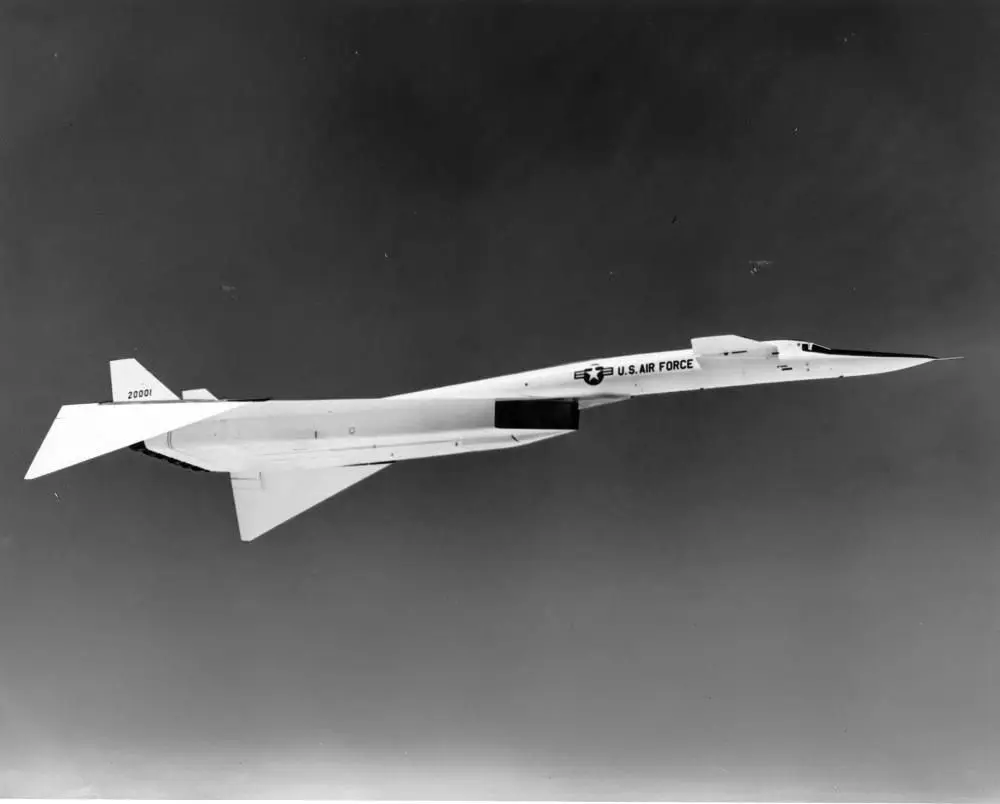
In the 1950s military experts believed that a bomber aircraft flying at such high speeds would be practically immune to intercepting fighter aircraft which was the only effective weapon against bombers at the time. The B-70 would simply outrun incoming threats and disappear before any danger got close. The higher service ceiling at 70.000 feet meant that the B-70 could also fly higher than them. The Air Force also expected that the high speeds would enable the B-70 to better escape the blast radius from the nuclear weapons it was built to carry.
Despite the lack of a stealth-incorporating design, the B-70 would still be difficult, if not impossible, to track on radar. Because of its high speeds the bomber would only appear on enemy radar screens for a short amount of time. Too short for the enemy to arrange a response. In certain conditions, the bomber would not even appear on the radar screens in the first place.

Another part that makes the XB-70 Valkyrie special is in a more technical (and planenerdy) field. The design drew on a special supersonic aerodynamic effect. To utilize this effect, the engineers equipped the XB-70 with some unique features.
We call the effect compression lift. The principle is to produce additional lift by using the shock waves generated by the sharp points on the aircraft, such as the nose or wing tips. Shock waves are essentially high pressure air and by managing these correctly, they can become a source of aerodynamic lift. On the XB-70 Valkyrie, the high pressure shock waves are captured on the bottom of the wings and used to provide additional lift to the aircraft. What makes the XB-70 special is the way it manages these shock waves under the wing. Engineers equipped the XB-70 with movable, drooping wing tips that are lowered at high speeds to maximize the compression lift effect under the wings. Added benefits of the hinged wingtips were increased directional stability.
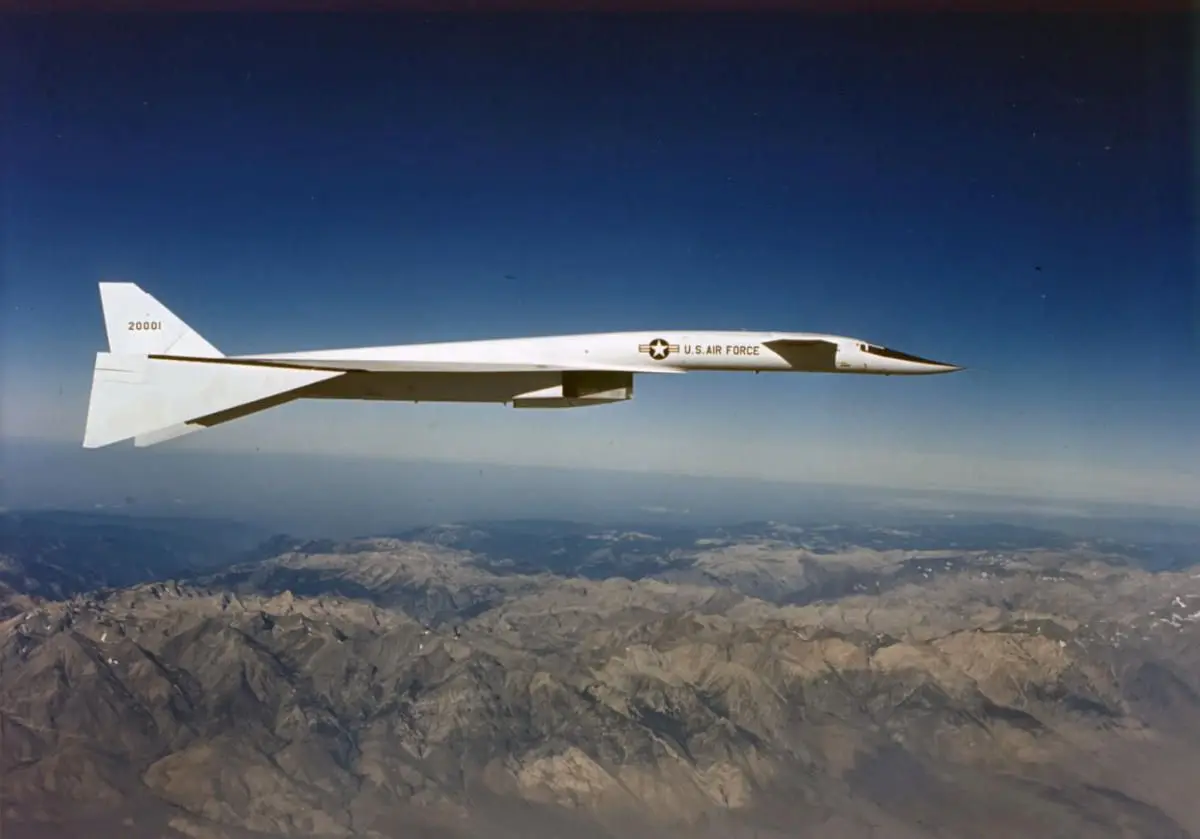
The XB-70 was also unique in its futuristic design and aerodynamics. When looking at the XB-70 Valkyrie a special feature cathes the eye: The smaller set of wings placed forward of the main wing. We call this a canard and they can offer many advantages on an aircraft. On the XB-70 they served as control surfaces since canards can increase aircraft maneuverability. They are also seen on more modern jets such as the Saab JAS 39 Gripen and Sukhoi Su-34.
Almost Became the World's First Nuclear-Powered Aircraft
After the United States Air Force issued the development of the XB-70 in 1955 the engineers considered two designs. A conventionally powered version with afterburning turbojet engines but also a nuclear powered version.
The latter were designated the Weapon System 125A. And the desire to explore a nuclear powered version of the XB-70 Valkyrie was not only hypothetical. Engineers built two nuclear aircraft engine prototypes based on the General Electric J47 turbojet engine. They went even further and successfully powered them to almost full thrust, using two shielded reactors.
Despite the initial success it became evident that the development cost of a nuclear powered aircraft would be enormous. Together with the dangers of carrying a nuclear reactor on a plane, nuclear powered aircraft, were cancelled. Including the nuclear version of the Valkyrie.
The now decommissioned nuclear engine prototypes, called HTRE-2 and HTRE-3, still exist and are open to the public at Idaho National Laboratory.
Cancellation and a New Life
The supersonic XB-70 Valkyrie was conceived in a time where the only effective defence against bomber aircraft were air fighters and anti-air artillery. Even then, the aa-guns proved only little effective. And fighter aircraft had more and more trouble keeping up with the improving performance of bombers.
But the introduction of the first Soviet surface-to-air missiles in the late 1950s changed that picture dramatically. Suddenly the XB-70 were much more vulnerable and even its Mach 3 speeds could not guarantee its survival.
To cope with the rising threat of Soviet missiles, the United States Air Force began to fly missions at a lower altitude where the enemy radar would have more trouble tracking its target. But at these lower altitudes, the XB-70 Valkyrie would be much less effective. So much in fact, that it would not perform better than the B-52. The bomber it was meant to replace. Mission range and fuel economy would also suffer when flying lower.
Another nail in the coffin for the XB-70 project was the development of the ICBM missiles in the late 1950s. The Valkyrie was specifically designed to carry the heavy nuclear weapons. But now the ICBMs threatened the role of the aircraft.

President Eisenhower was not a big believer in the Valkyrie project as he saw no real need for the aircraft. His main points against it was the same as the above mentioned ones: Rockets and missiles was a threat and ICBMs were "a cheaper, more effective way of doing the same thing" he said. He also pointed out that the aircraft, that was still in development, would be obsolete at the time it was ready for full-scale manufacturing. Technology would simply have caugth up to the Valkyrie.
The Eisenhower administration cut the project to a single prototype.
Kennedy however endorsed the XB-70 and it actually became a part of his election campaign to do so. But at the time he became president, the XB-70 Valkyrie project had already cost equal to almost $7 billion today. A hefty sum for a bomber. So in 1961 he canceled the project. It had become too expensive and unnecessary.
Instead Kennedy changed the XB-70 program to a research project. The Valkyrie was perfect for exploring the effects of supersonic flight and propulsion.
North American Aviation completed the first prototype, called AV-1, in May 1964 in Palmdale California. A second prototype, the AV-2, quickly followed in October the same year. A third prototype was planned but it got cancelled.
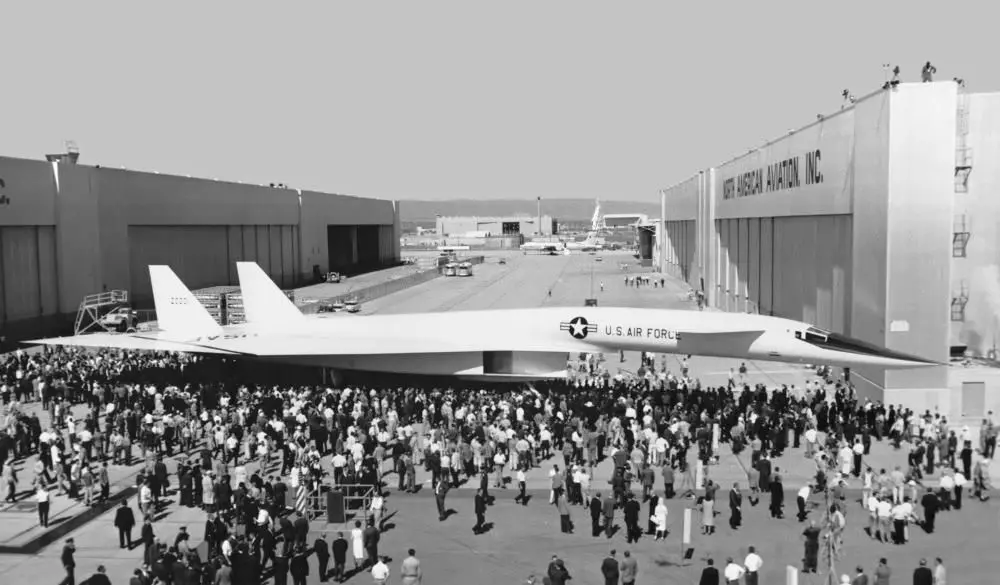
In September 1964 the first XB-70 embarked on its first flight. The Valkyrie first went supersonic when it reached Mach 1.1 on the third test flight on 12 October 1964. It first surpassed Mach 3 on 14 October 1965 where the AV-1 reached Mach 3.02 at 70.000 feet.
The AV-2 followed in its sisters footsteps and became the one to hold the record for the highest speed of the two prototype aircraft: In April 1966 the AV-2 reached and maintained a top speed of Mach 3.08 for 20 minutes. A month later, the AV-2 flew at Mach 3.06 for 32 minutes and covered a distance of 3.900 km (or 2.400 miles) in the 91 minutes flight time.
Findings from the flight studies were used in the design of the Rockwell B-1 Lancer bomber program and in the Tupolev Tu-144 via Soviet espionage.
The Fatal Photoshoot
In June 1966 the XB-70 number two (AV-2) was flying in close formation during a photoshoot over California, near Edwards. The Air Force arranged the photoshoot on behalf of General Electric, the manufacturer of the Valkyries engines. Four other aircraft was part of the formation. An F-4 Phantom, an F-5, a T-58 Talon and an F-104 Starfighter.
Flight Research pilot Joe Walker, who had previously flown the rocket powered North American X-15 and the lunar lander research vehicle, was flying the F-104 Starfighter close to the XB-70's right wing.
Out of nowhere, the F-104 Starfighter drifted into the XB-70's right wing without a warning. The Starfighter then flipped and rolled inverted over the top of the Valkyrie and hit the bomber's vertical stabilizers and left wing.
The F-104 Starfighter exploded and ripped off the XB-70's rudder and damaged the left wing. The explosion killed pilot Joe Walker instantly.
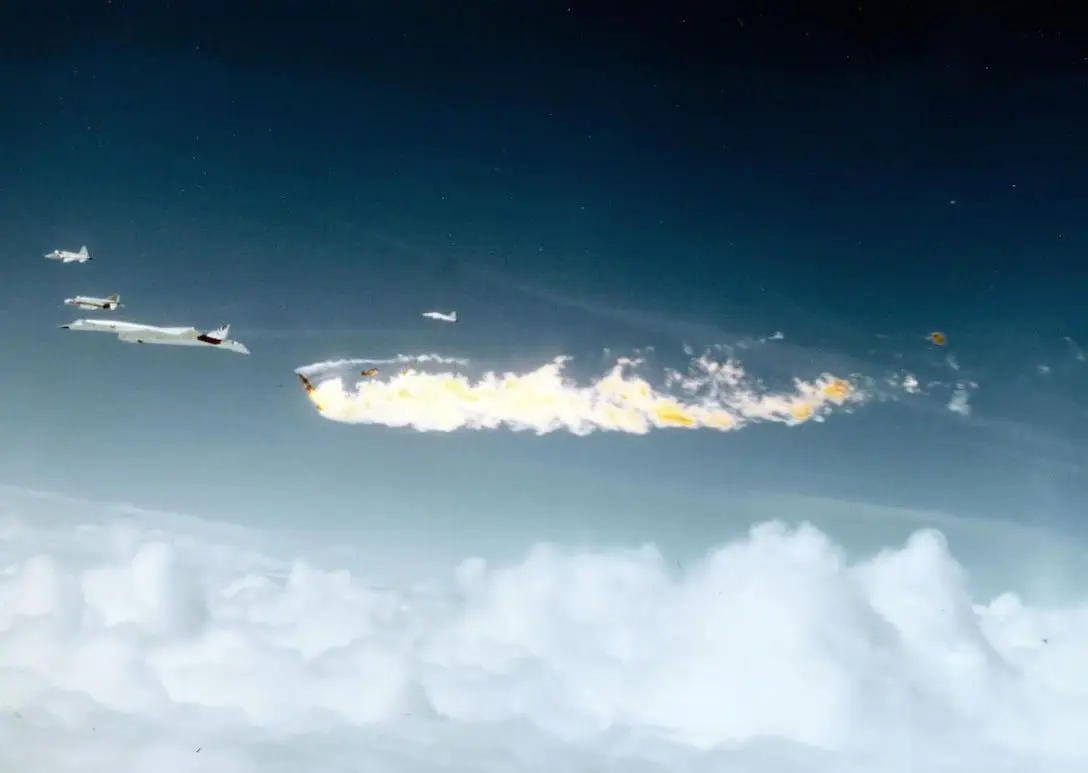
The vertical stabilizer is an indispensable part of an aircraft. Without the rudder and with other vital control surfaces damaged, the XB-70 struggled to keep its stability. It managed to fly straight and level for about 16 seconds before it began a slow roll into an uncontrolled spin. It crashed north of Barlow, California. XB-70 co-pilot Carl Cross died in the crash while pilot Al White managed to eject and survive.
Investigations stated that because of the position of the F-104 Starfighter, in relation to the Valkyrie, Joe Walker could not see the XB-70's wing. It was likely that he maintained his position in the formation by only referencing the forward part of the Valkyrie's fuselage which he was able to see. Investigators believed that his lack of proper visual indicators caused the drift into the XB-70's wing. It was also concluded that the wake vortex from the XB-70 was the reason for the Starfighter's roll after the initial striking.
The remaining Valkyrie continued in the supersonic flight research program until its retirement.
The XB-70 Valkyrie Legacy and Summary
The XB-70 Valkyrie last went supersonic in December 1968. In February the following year, the Valkyrie AV-1 took its final flight to the National Museum of the United States Air Force near Dayton, Ohio. It is still on display there.
The XB-70 Valkyrie was indeed ahead of its time. Despite a turbulent life from development to retirement, the futuristic supersonic bomber amazes with its looks, perfomance and history.
It was a product of the Cold War where experts thought that Mach 3 speeds and higher altitudes could protect a bomber carrying nuclear weapons. But development costs and advances in technology eventually made the XB-70 Valkyrie unnecessary.
Instead, the bomber was used in a research project aimed to study supersonic flight. The Valkyrie generated valuable insights about supersonic flight. Insights that were later used in other military aircraft.
The crash in 1966 became a darker chapter in the history of the aircraft. But the remaining Valkyrie continued its work in research and eventually went on display in 1969 in a museum in Ohio.
It can still be seen there and if you get the chance, go pay a visit.

The XB-70 Valkyrie in Numbers and Facts
- Manufacturer: North American Aviation
- First flight: 21 September 1964
- Retired: 4 February 1969
- Number built: 2
- Cost per aircraft: About US$ 750 - Equivalent to about US$ 5,2 billion today.
- Length: 56,39 m, 185 ft
- Wingspan: 32 m, 105 ft
- Engines: 6 x General Electric YJ-93-GE-3 turbojets with afterburners.
- Maximum speed: Mach 3.1 (3.310 km/h, 2.056 mph)
- Gross Weight: 242.536 kg or 534.700 pounds
- Range: 6.899 km, 4.287 mi.
- Max altitude: 77.350 ft.
- Longest flight: 3h 40m on 6 January 1966
- Fastest speed: 3.250 km/h, 2.020 mph on 12 January 1966
- Highest altitude: 74.000 ft on 19 March 1966
- Longest sustained Mach 3: 32 minutes on 19 May 1966
- Total time flying Mach 3: 108 minutes over 10 flights
Planenerd Newsletter
Join the newsletter to receive the latest updates in your inbox.






